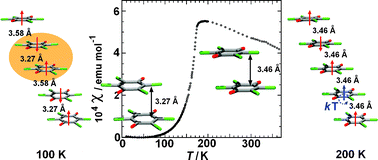Temperature induced reversible structural and magnetic changes in a crystal of tetrachlorosemiquinone anion radical†
Abstract
The anion radicals with nonaromatic π-systems, such as

* Corresponding authors
a
Department of Physical Chemistry, Rudjer Bošković Institute, Bijenička 54, Zagreb, HR-10000, Croatia
E-mail:
kojic@irb.hr
Fax: +385 1 468 0245
b Department of Physics, Faculty of Science, University of Zagreb, Bijenička 32, Zagreb, HR-10000, Croatia
The anion radicals with nonaromatic π-systems, such as

 Please wait while we load your content...
Something went wrong. Try again?
Please wait while we load your content...
Something went wrong. Try again?
K. Molčanov, B. Kojić-Prodić, D. Babić, D. Pajić, N. Novosel and K. Zadro, CrystEngComm, 2012, 14, 7958 DOI: 10.1039/C2CE25893E
To request permission to reproduce material from this article, please go to the Copyright Clearance Center request page.
If you are an author contributing to an RSC publication, you do not need to request permission provided correct acknowledgement is given.
If you are the author of this article, you do not need to request permission to reproduce figures and diagrams provided correct acknowledgement is given. If you want to reproduce the whole article in a third-party publication (excluding your thesis/dissertation for which permission is not required) please go to the Copyright Clearance Center request page.
Read more about how to correctly acknowledge RSC content.
 Fetching data from CrossRef.
Fetching data from CrossRef.
This may take some time to load.
Loading related content
